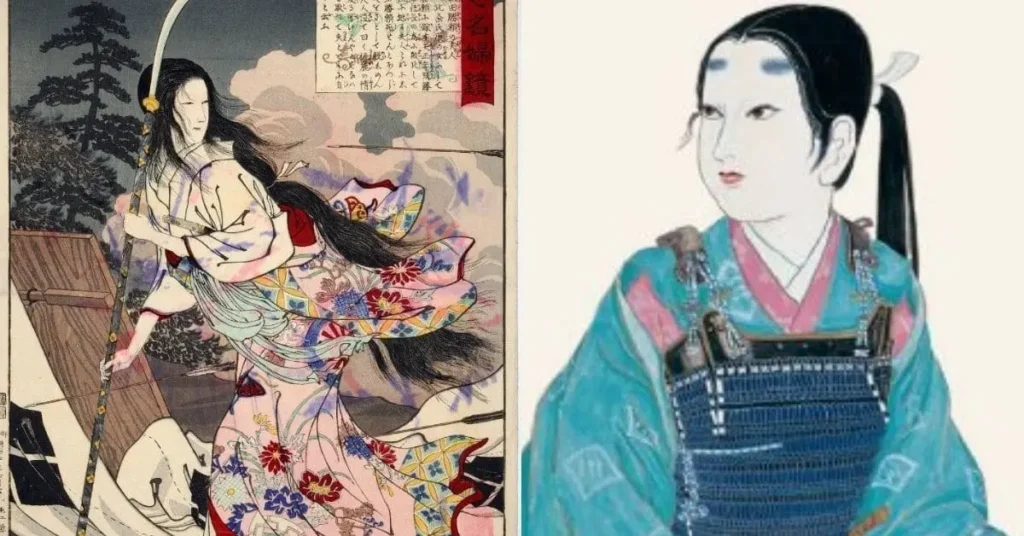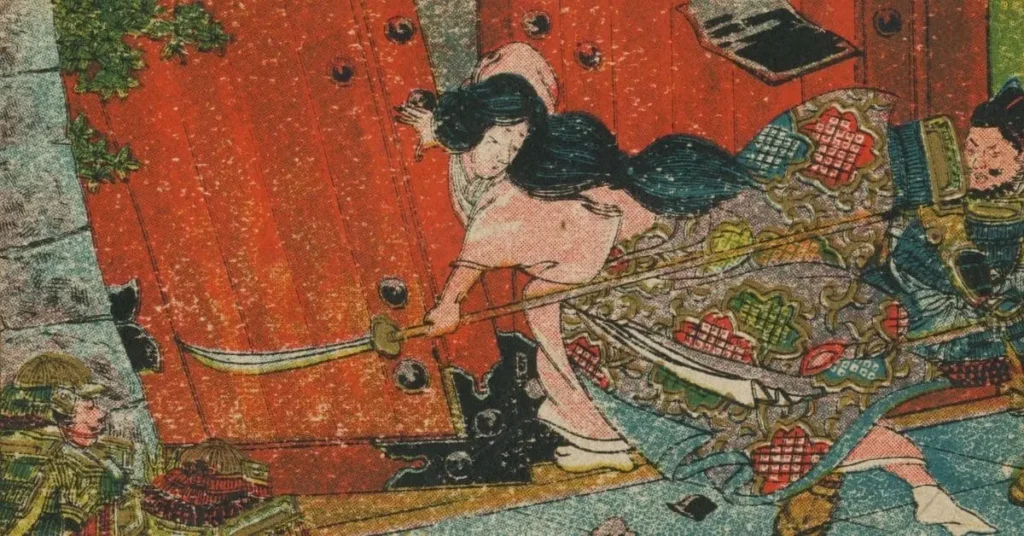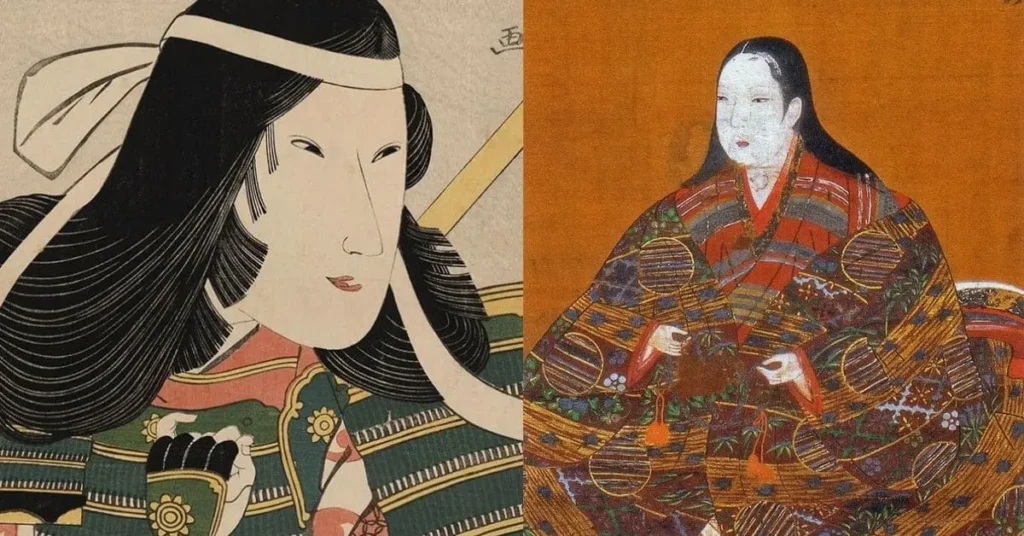Onna-Bugeisha were formidable female Samurai warriors who existed long before the misconception that Samurai were exclusively male became popular. These women, skilled in both offense and defense, were every bit as powerful, smart, and deadly as their male counterparts.
Trained similarly, they even had a specialized weapon, the Naginata, designed to suit their smaller stature. Onna-Bugeisha fought alongside male samurai, sharing the same standards and duties. It is believed at one points of time, 10% of the Japanese population were samurai and half of them were Onna-Bugeisha.
As an integral part of samurai clans across Japan, they played crucial roles in protecting villages. The Onna-Bugeisha legacy extended to opening schools to train young women in the art of war and Naginata use, showcasing their significant influence in Japanese martial history. Some of these female samurai warriors were so skilled that their names are still remembered today. Who are these famous female Samurais? Let’s find out
Ohori Tsuruhime
Ōhōri Tsuruhime, born in 1526, was a famous Sengoku period female samurai warrior, often compared to Joan of Arc for her divine inspiration and combat skills. The daughter of Ōhōri Yasumochi, the chief priest of Ōyamazumi Shrine on Ōmishima Island, she inherited her martial prowess and divine connection. Facing threats from Ōuchi Yoshitaka, who sought control of the region in 1534, Tsuruhime lost two elder brothers in the conflict.

In 1541, at the age of 15, Tsuruhime assumed the role of chief priestess after her father’s death and defended Ōmishima from Ōuchi attacks. Leading a surprise counterattack, she successfully drove the invaders into the sea. In a daring move, Tsuruhime personally confronted Ōuchi general Ohara Takakoto, defeating him in a duel and securing a significant victory.
Tsuruhime continued her resistance against Ōuchi forces in 1543. Overwhelmed with grief after the death of her fiancé Yasunari Ochi, the sumaria woman set up an ambush and defeated the Ōuchi army. According to legend, mourning her lost love, Tsuruhime committed suicide by drowning, leaving behind powerful last words engraved in Mishima’s ocean.
While romanticized, there are no contemporary records confirming Tsuruhime’s fate, but her legacy endures as one of Japan’s most recognized female warriors.
Hojo Masako
Hōjō Masako, born in 1157, was a formidable Japanese political figure during the early years of the Kamakura period. Known as the “nun shogun,” she played a pivotal role as the wife of Minamoto no Yoritomo and the mother of shoguns Minamoto no Yoriie and Minamoto no Sanetomo. As the eldest daughter of Hōjō Tokimasa, leader of the influential Hōjō clan in Izu province, her upbringing amidst war and strife shaped her resilient character.
Married to Yoritomo against her father’s wishes in 1177, Masako actively engaged in government administration, symbolizing power for the Hōjō clan. She navigated the tumultuous Genpei War, where the Minamoto eventually triumphed over the Taira. Yoritomo became the undisputed leader, and Masako stood by him, riding into battles and earning a reputation for never being defeated.
After Yoritomo’s death in 1199, Masako, now a Buddhist nun, continued to wield influence alongside her family. Despite familial strife, including the arrest and execution of her half-brothers Yoshitsune and Noriyori, and the murder of her son Yoriie in 1204, Masako’s political acumen prevailed. She played a key role in placing Kujō Yoritsune as the next shogun after the death of her son Sanetomo in 1219.
During the Jōkyū War of 1221, Masako confronted challenges, notably quelling the rebellion of Cloistered Emperor Go-Toba. Her leadership, as documented in the Azuma Kagami, showcased her ability to rally vassals and maintain stability. Masako died in 1225 at the age of 69, leaving a lasting legacy.
Her cloistered rule earned her the title “nun-shōgun,” emphasizing her influential role beyond traditional gender norms. In the realm of fiction, Masako’s character continues to be a fascinating subject, reflecting her historical significance in Japanese medieval politics.
Hangaku Gozen
Hangaku Gozen, also known as Lady Hangaku, was a remarkable female samurai warrior during the transition from the Heian to the Kamakura period in Japan. Born into the Taira clan, Hangaku lived in Echigo, present-day Niigata Prefecture. Her father, Jō Sukekuni, was a warrior allied with the Taira.

Hangaku gained prominence during the Kennin Rebellion in 1201, fighting alongside her uncle, Jo Nagamochi, and cousin, Jo Sukemori, against the Kamakura shogunate. Noted for her leadership and bravery, Hangaku played a crucial role in the defense of Torisaka Castle. Disguised as a boy, she stood on the castle tower, skillfully using her archery to repel attacks, earning admiration for being “fearless as a man and beautiful as a flower.”
Despite a valiant three-month defense, Hangaku was eventually wounded by an arrow and captured. Presented to Shogun Minamoto Yoriie, her reputation and beauty intrigued him. Instead of ritual suicide, Yoriie ordered her to marry his retainer, Asari Yoshito. Hangaku’s later life is less documented, but it is reported that she had a daughter with Yoshito and lived in Kai Province. Her legacy as a female samurai in Japanese history continues to endure.
Tomoe Gozen
Tomoe Gozen, an onna-musha, a samurai woman, from the late Heian period in Japanese history, played a significant role in the Genpei War, a conflict pivotal to the establishment of the first shogunate. Serving under Minamoto no Yoshinaka, she commanded 300 samurai against the Taira clan’s 2,000 warriors.
Her exploits during the Battle of Awazu in 1184 are celebrated, where she beheaded Honda no Morishige and killed Uchida Ieyoshi. After defeating the Taira in 1182, Yoshinaka aspired to lead the Minamoto clan, leading to a confrontation with his cousin Yoritomo’s forces.

In the face of defeat at Awazu, Yoshinaka urged Tomoe to flee, expressing a desire to die with his foster brother. Tomoe’s bravery, including presenting the head of the Musashi clan’s leader to Yoshinaka, has immortalized her in the Tale of the Heike and various cultural forms, resonating through books, music, poems, films, and historical novels.
Yodo-Dono
Yodo-dono was a prominent figure during Japan’s late Sengoku period. Born to Azai Nagamasa and Oich in a noble family, Yodo-dono became the concubine and second wife of Toyotomi Hideyoshi, the most powerful man in Japan at the time.
She played a crucial role in restoring the Toyotomi clan to power after the fall of the Council of Five Elders while acting as the guardian of Hideyori, her son with Hideyoshi. Yodo-dono, alongside Hideyori, led the last anti-Tokugawa shogunate resistance in the siege of Osaka.
Her familial connections, including sisters Oeyo and Ohatsu linked to the Tokugawa clan, were vital for maintaining diplomatic relationships between the Toyotomi and Tokugawa clans. However, as tensions rose between the two clans, Yodo-dono faced accusations of planning the Toyotomis’ demise and was frequently portrayed as a “wicked and wanton” woman.
After Hideyoshi’s death, Yodo-dono faced challenges in preserving the Toyotomi legacy. The Battle of Sekigahara in 1600 marked a turning point, and Yodo-dono actively resisted Tokugawa rule. The construction of Osaka Castle and the Hoko-ji Temple Bell Incident escalated tensions.
The Siege of Osaka in 1614 and 1615 culminated in tragedy, with Yodo-dono and Hideyori committing suicide in the flames of Osaka Castle, marking the end of the Toyotomi clan. Legends and speculations about her fate have persisted due to the lack of eyewitness accounts or records detailing her final moments.
Also Read: 7 Deadly Samurai Weapons of the Japanese
